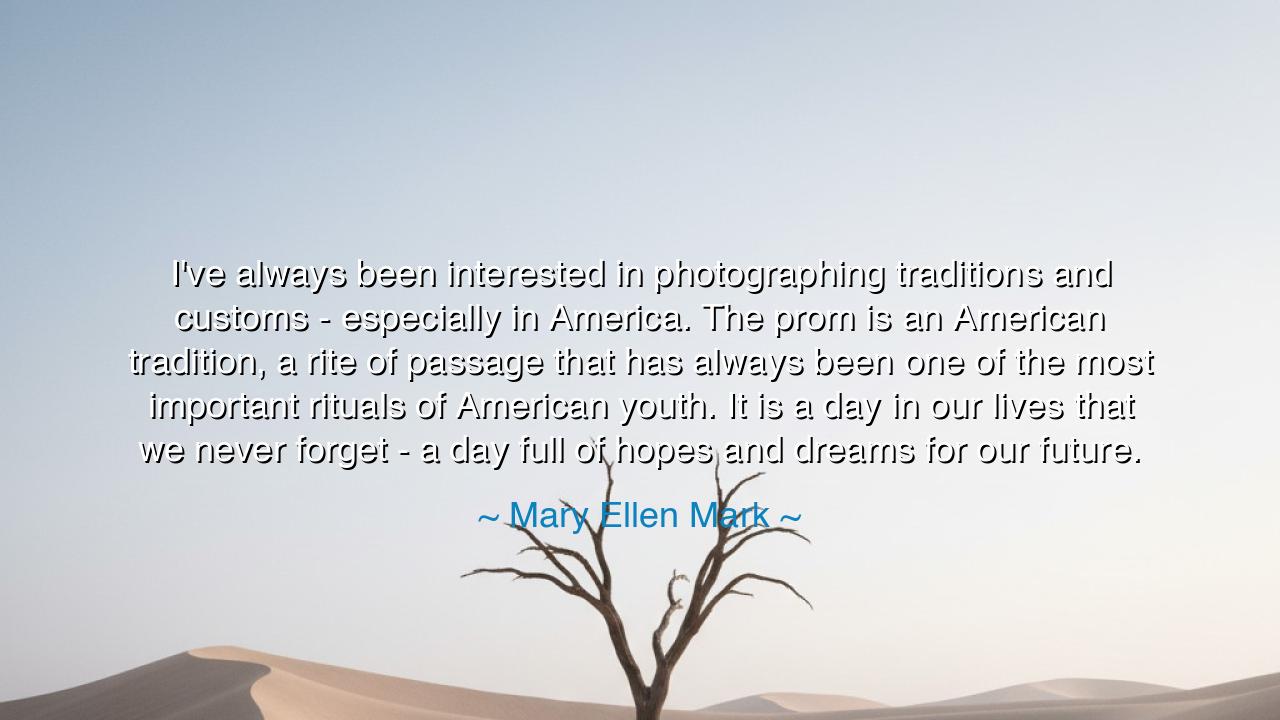
I've always been interested in photographing traditions and
I've always been interested in photographing traditions and customs - especially in America. The prom is an American tradition, a rite of passage that has always been one of the most important rituals of American youth. It is a day in our lives that we never forget - a day full of hopes and dreams for our future.






In the passage of time, there are certain moments in life that transcend the mundane, becoming rituals that bind generations together. These traditions and customs speak to the heart of who we are, to the values we hold, and to the ways in which we mark the milestones of our existence. The words of Mary Ellen Mark, “I’ve always been interested in photographing traditions and customs - especially in America. The prom is an American tradition, a rite of passage that has always been one of the most important rituals of American youth. It is a day in our lives that we never forget - a day full of hopes and dreams for our future,” shine a light on one such rite of passage—the prom—a quintessentially American tradition that serves as a mirror reflecting the hopes, dreams, and anxieties of youth.
Mark’s reflection on the prom as an iconic rite of passage speaks to the powerful role that rituals play in shaping our collective experience. A rite of passage is not merely an event; it is a moment in which individuals are transformed, passing from one stage of life to another. In this context, the prom becomes more than just a dance or party—it symbolizes the transition from adolescence to adulthood, a moment where dreams are woven into the fabric of one’s future. Much like the ancient rites of initiation that marked the coming-of-age of young people in ancient Greece, the prom serves as a ceremonial gateway, a time when youth look to the future with hope and anticipation.
Historically, the rite of passage has been an essential part of human society, marking a shift in an individual’s role within the community. In ancient cultures, this transition was often marked by tribal ceremonies or sacrifices, designed to help the individual embrace their new responsibilities. Consider the ancient Spartans, who at the age of seven, were taken from their homes to undergo a strict military training regimen, transforming them from children into warriors. Similarly, the prom marks the shift from the protective, often sheltered life of a teenager into the vast world of adulthood, where dreams of the future take shape and choices carry weight. It is in this moment of transformation that the prom finds its place in the hearts of young people, an indelible mark on their memory.
The American prom, while a modern invention, carries with it the same power as these ancient rites. It is a moment of celebration, a time when young people come together to recognize not only the end of a chapter in their lives but also the possibilities that lie ahead. Like the ancient rituals, the prom allows youth to dream, to see the potential of who they might become. It is, as Mark observes, “a day full of hopes and dreams for our future,” a day where the promises of youthful ambition are given room to breathe. These hopes are not just fleeting thoughts; they are the vision of a future that feels tangible, a future filled with promise, uncertainty, and the unknown.
One can look to the example of ancient Rome, where the coming-of-age rituals were infused with a deep sense of duty and purpose. A Roman boy, upon reaching adulthood, would stand before his family and the gods, acknowledging his responsibilities and pledging to uphold the values of his community. Similarly, the prom is a moment where young people begin to acknowledge their place in the larger society, beginning to understand the weight of their dreams and the paths they will take. It is a rite where they are invited to imagine the future, just as the Roman youth did, and to set a course toward their destiny.
Mark’s dedication to capturing these traditions and customs through her photography is a reflection of the enduring power of ritual in shaping the human experience. Through her lens, we see not just the surface of these events, but the emotion and symbolism that underpins them. The prom is not just a night of music, dance, and celebration; it is a profound moment of self-reflection, of recognizing the past while stepping into the unknown future. It serves as a reminder that traditions are not static but are living, breathing embodiments of the dreams and hopes of those who participate in them.
And so, the lesson to be drawn from Mark’s words is clear: we must not underestimate the power of rituals in our lives. Whether they are as grand as the prom or as simple as the daily routines we perform, these moments of transition and celebration serve to remind us of the dreams that guide us. They mark our passage through life and provide us with the strength to face the challenges ahead. Let us honor the traditions that shape us, knowing that in these rituals lies not only the remembrance of the past but the promise of the future. Each ceremony, each rite of passage, carries with it the weight of our hopes, the echoes of our ancestors, and the endless potential of what we might become.






AAdministratorAdministrator
Welcome, honored guests. Please leave a comment, we will respond soon